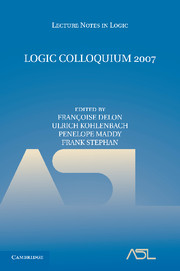Book contents
- Frontmatter
- Contents
- Introduction
- Speakers and Titles
- Decorated linear order types and the theory of concatenation
- Cardinal preserving elementary embeddings
- Proof interpretations and majorizability
- Proof mining in practice
- Cardinal structure under AD
- Three lectures on automatic structures
- Pillay's conjecture and its solution—a survey
- Proof theory and meaning: On the context of deducibility
- Bounded super real closed rings
- Analytic combinatorics of the transfinite: A unifying Tauberian perspective
- References
Bounded super real closed rings
Published online by Cambridge University Press: 01 March 2011
- Frontmatter
- Contents
- Introduction
- Speakers and Titles
- Decorated linear order types and the theory of concatenation
- Cardinal preserving elementary embeddings
- Proof interpretations and majorizability
- Proof mining in practice
- Cardinal structure under AD
- Three lectures on automatic structures
- Pillay's conjecture and its solution—a survey
- Proof theory and meaning: On the context of deducibility
- Bounded super real closed rings
- Analytic combinatorics of the transfinite: A unifying Tauberian perspective
- References
Summary
Introduction. This note is a complement to the paper, where super real closed rings are introduced and studied. A super real closed ring A is a commutative unital ring A together with an operation FA : An → A for every continuous map F : ℝn → ℝ, n ∈ ℕ, so that all term equalities between the F's remain valid for the FA's. For example if C(X) is the ring of real valued continuous functions on a topological space X, then C(X) carries a natural super real closed ring structure, where FC(X) is composition with F. Super real closed rings provide a natural framework for the algebra and model theory of rings of continuous functions.
A bounded super real closed ring A is a commutative unital ring A together with an operation FA : An → A for every bounded continuous map F : ℝn → ℝ, n ∈ ℕ, so that all term equalities between the F's remain valid for the FA's (cf. 2.7 below).
In particular every super real closed ring is a bounded super real closed ring by forgetting the operation of the unbounded functions. An example of a bounded super real closed ring, which is not a super real closed ring, is the ring Cpol(ℝn) of all polynomially bounded continuous functions ℝn → ℝ.
- Type
- Chapter
- Information
- Logic Colloquium 2007 , pp. 220 - 237Publisher: Cambridge University PressPrint publication year: 2010
References
- 1
- Cited by



